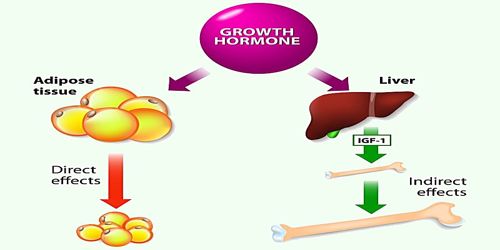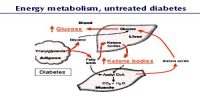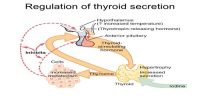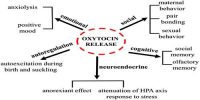The Growth hormone
Source: Secreted by somatotropes of an anterior pituitary gland. The major role of growth hormone in stimulating body growth is to stimulate the liver and other tissues to secrete IGF-I. It also helps to control body composition, body fluids, muscle and bone growth, sugar and fat metabolism, and perhaps heart function.
Chemical nature: A small protein molecule,
No of amino acids – 191,
Molecular weight – 22,005
The half-life of circulating growth hormone: 6 – 20 minutes.
Level: The basal plasma GH level measured by RIA is normally < 3 mg/ml.
5 – 20 years (67 mg/ml)
20 – 40 years (3 mg/ml)
40 – 70 years (1.6 mg/ml)
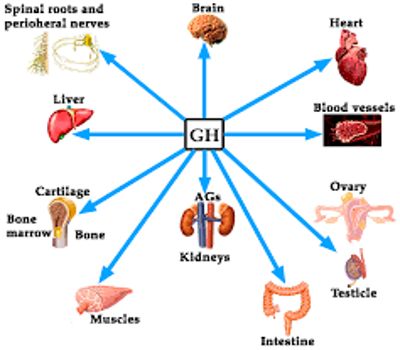
Fig: Growth Hormone
Mode of action of the growth hormone:
Growth hormone encourages growth and development in children and adolescents. Most of the growth effect of growth hormones results from somatomedin C and other somatomedins secreted by the liver and other tissues rather than from the direct effect of growth hormone on the bones and peripheral tissues. It is recently advocated that the action of GH is mediated through the cyclic AMP (second messenger system). It is also involved in regulating bodily fluids, sugar and fat metabolism and maybe even heart function.
(a) Binding of GH with its receptor:
GH has two binding sites for the receptor. When it binds one site, another site attracts another GH molecule, producing dimer. Dimerization is essential for receptor activation.
(b) Cyclic AMP (Second messenger)
Through this process, the intracellular action of GH occurs.
Growth Hormone has 3 basic metabolic functions –
(i) It is a protein anabolic hormone (Increase protein deposition)
(ii) It is a diabetogenic hormone (Increase blood glucose)
(iii) It is a ketogenic hormone (Increase circulating FFA)
Functions of the Growth Hormone
(A) GENERAL BODY GROWTH: In general, GH increases the size & number of cells and thus causes the growth of almost all tissues of the body that are capable of growing.
- Muscle: GH stimulates the growth of muscle,
- Viscera: GH increases the growth of liver, kidney, and alimentary tract,
- Thymus: GH stimulates the growth of the thymus.
- Milk secretion: GH stimulates milk secretion.
(B) METABOLIC FUNCTIONS:
(i) On protein Metabolism – GH is a protein anabolic hormone because it increases protein deposition by –
- ↑ ammo acid transport through the cell membrane,
- ↑RNA translation to cause protein synthesis by the ribosome.
- ↑ Nuclear transcription at DNA to RNA.
- ↓ Break down of protein and amino acid.
(ii) On fat metabolism – It ↑ fat utilization for energy by –
- ↑ release of fatty acid from adipose tissue,
- ↑ the conversion of the fatty acid to acetyl CoA.
- It has a ketogenic effect.
(iii) On CHO metabolism – It increases blood glucose by –
- ↓ utilization of glucose by cells,
- ↑ glycogen deposition,
- ↓ uptake of glucose by the cells,
- ↑ Secretion of insulin.
(C) EFFECT ON ELECTROLYTE METABOLISM:
- GH increases intestinal absorption of Calcium,
- Na+ and K+ excretion is reduced by an action independent of the adrenal gland,
- Excretion of amino acid 4-hydmicypmline is increased,
(D) STIMULATION OF CARTILAGE and BONE GROWTH:
- Increased deposition of protein by the chondrocyte and osteoblast cells finally cause bone growth.
- Increase the rate of production of chondrocytes and osteogenic cells.
- A specific effect of converting chondrocytes into osteogenic cells, thus causing specific deposition of new bone.
